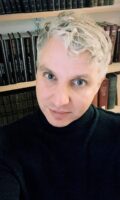The recent ‘Opening up the Archives’ event held at the University of Exeter on 30 October explored the relationship between archives, digital technology and creativity. Dr Michael Goodman, GW4 Project Outreach Officer for the Special Collections and Archives at Cardiff University, explains the significance of the archives and how GW4 Treasures can help us make connections between the past and present.
The ‘GW4 Treasures’ consist of each institutions’ Special Collections and Archives holdings. When taken together these contain of over 10km of rare books, 5km of manuscripts and include archives from the 11th Century to the modern day. From cartoons to personal diaries, maps to political pamphlets, GW4 Treasures tell us who we were, who we are and, importantly, what we might become. In an age when the digital pervades every aspect of our lives, the GW4 Treasures allow us to look to the past to make sense of the present.
The ‘Opening up the Archives’ event at the University of Exeter, supported by GW4 Treasures, looked at the nature of archives and our relationship to them by asking ‘what is the connection between archives and digital technology? What happens, for example, when archives and collections are ‘remediated’ (transformed into a different medium, in this case the digital?) What is gained and lost in this process? How can we improve such remediated archives? How can we better engage the public with these new resources and, finally, how can we creatively respond to these archival collections? Through a series of talks and a showcase of the University of Exeter’s Digital Humanities Lab, the event brought academics, archivists and creative practitioners into discussion with each other, providing a rich and valuable space to think through these complex ideas and concepts.
In the Digital Humanities Lab, historical objects were recreated through 3D printing techniques. It provided participants with an insight into not just what the technology is capable of (pretty much anything), but also the length of time it can take to ‘print’ a model – often as much as twelve hours and sometimes even as long as a week depending on the size and complexity of the object being printed. As remarkable as this technology is currently, one can only imagine how it will develop and become available to the mass market in the next decade. Instead of digital archives that consist mainly of 2 dimensional documents and images, they will soon contain objects and items where you will be able to print highly accurate digital copies of them at home. It really does have the potential to redefine research and the nature of what and how we study.
The Digital Humanities team can digitise images and documents to an incredibly high standard and demonstrated a technique called photogrammetry where an object is photographed from many different angles and distances to create a realistic 3D digital model. This then allows researchers to view the object on the screen so that they can easily and effectively analyse it, safe in the knowledge that the original (and often very fragile) item is being carefully preserved. With the development and recent refinements of Virtual Reality and haptic feedback, it will only be a matter of years before researchers can look at these objects in virtual space and feel the weight of them.
There were two presentations from the Digital Humanities Lab’s Professor Leif Isakson and Dr Charlotte Tupman. Professor Isakson, in a fascinating talk called ‘Web Technologies and the Archive: Challenges and Opportunities’, discussed how he had used digital mapping techniques to find the remains of an old fort in Scotland at Cluny Hill. He reminds us that the real power of the digital and digital practice is when it is combined with more ‘analogue’ and traditional ways of doing research. In short, the two are not mutually exclusive and both analogue and digital should support each other to create exciting and powerful new work.
Dr Tupman, meanwhile, explored how she had she had been working on a project that would open up the Powderham Archives for research and other forms of engagement by using the latest digital technology to recreate a medieval family tree. Tupman explained how they stitched together many photographs to reconstruct the family tree. The final speaker of the day was Jeanie Sinclair who led a workshop on creative responses to archival material and how we choose to create stories and histories when we look at such documents.
The ‘Opening up our Archives’ event brought together people with different research interests to celebrate, discuss and think about collaborating on future projects together. Furthermore, it demonstrated that research within GW4 is enriched when we work together and that by working with special collections, we can make extraordinary (physical and digital) connections.
- Many thanks to Dr Christine Faunch and her team and everyone at the University of Exeter’s Digital Humanities Lab







